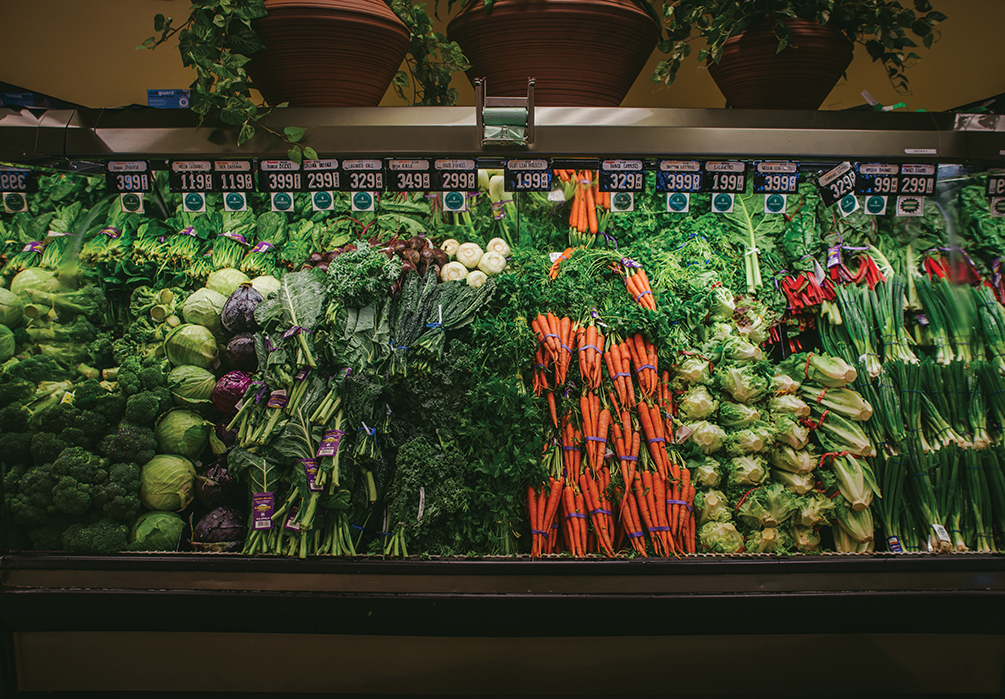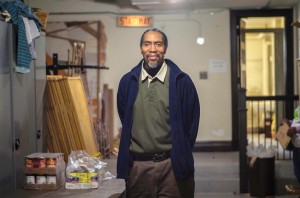
Every Saturday from ten to one, the basement of Hyde Park Union Church, at 56th and Woodlawn, becomes a food pantry, distributing groceries and providing information on nutrition and health programs. As part of the Hyde Park and Kenwood Hunger Programs, the pantry operates on an annual budget of $110,000, most of which is raised through private donations. The church’s staff administers the pantry, but it’s manned by volunteers. On this particular day, a bureaucratic-looking woman shuffles through a box of manila folders, looking for the right one, while children dart around in weather-beaten windbreakers, weaving past legs and furniture. Dingy, unheated, with all the allure and charm of a Cold War fallout shelter, the church basement is a bit of a grim place.
In order to receive food, individuals are required to provide ID for everyone in their household and prove residence within the area bounded by Cottage Grove, Lake Michigan, and 39th and 60th Streets. Visits are limited to one every four weeks. Even with these restrictions, Lee Stapleton, a social worker whose weekly presence is paid for by the Hunger Programs, says there has been “a precipitous climb” in the number of people coming in to collect food over the past couple of years. Alvin Palmer, a volunteer, recounts that where there used to be six or seven people coming in when the pantry opened, now there are lines of “twenty or more.” Both mention the fact that the pantry has begun to run out of food more quickly. Many families now receive less as a result.
Part of what has contributed to this recent increase in hunger is undoubtedly the growing number of people living at or below the poverty line ($23,550 for a family of four), presumably as a result of the economic recession. According to a study by the Social IMPACT Research Center, a non-profit that studies poverty in Illinois, the four Chicago community areas with the highest percentage of residents living in extreme poverty are all located on the South Side (Riverdale, Burnside, Englewood, and Washington Park). The same study also showed that over the last ten years, the poverty rate has increased across almost all of the South Side. Pullman, for example, contains approximately the same number of people living in poverty as ten years ago; due to population decline, however, the rate of poverty has actually increased by four percentage points, to 26.8 percent. Many of these recent increases stand in sharp contrast to the trends of the 1990s. Census data shows that from 1990 to 2000, fewer than one-third of South Side neighborhoods experienced poverty rate increases of more than 2.4 percent, and more than a quarter of neighborhoods lowered their poverty rate.
In an effort to combat the rise of hunger cases, the 2009 stimulus bill expanded the Supplemental Nutrition Assistance Program, commonly known as the food stamp program. Increased funding for SNAP allowed it to provide more benefits and increased coverage for its recipients; a U.S. Department of Agriculture report showed that a household of four experienced a 27.2 percent increase in monthly benefits, from $294 to $374. As more people received more benefits, the cost of the program nearly doubled, growing from $33.2 billion to $78.4 billion in the past five years.

On October 31, however, Congress allowed the federal expansion of SNAP to expire, rejecting Democratic proposals to renew this part of the stimulus and, in the process, cutting food stamp benefits for approximately forty-seven million Americans. According to a report by the Center on Budget and Policy Priorities, a research and policy institute in D.C., these reductions will lead to a $5 billion drop in food stamp distribution in 2014. This means that many families will be forced to cut their food budgets, as most individuals will receive less than $1.40 per meal, while households of four face a reduction of $36 a month.
At the same time, Republicans in the House are currently trying to push through a version of the Farm Bill, (which, through the USDA, funds food stamps) that will cut an additional $40 billion from SNAP over the next decade. Speaker John Boehner, a Republican from Ohio, has argued that the reduction in the Farm Bill discourages wasteful spending on benefits and “makes getting Americans back to work a priority again for our nation’s welfare programs.” While it appears increasingly unlikely that the bill will manage to pass before the House begins its winter recess on December 13, thus delaying it until January’s legislative session, many Democratic representatives now support somewhere between $8 and $10 billion in cuts. The question, it seems, is not whether or not there will be cuts, but how extensive they will be.
Many of the people at Hyde Park Union Church would agree with Representative Boehner’s assertion that SNAP has not been wholly successful, but for entirely different reasons. Jacqueline Turner, sixty-two, relates how she has been forced to come out of retirement and look for work in order to help provide for her diabetic aunt, who is ninety-three. “Why attack the poor people?” she asks indignantly about the food stamp cuts. The process of visiting this food pantry, she says, is already humiliating enough.
The woman next to her, who declines to give her name, agrees. She can no longer afford to eat three meals a day, she says, but instead has a light tea with breakfast, and later a small lunch, so that she is able to afford a substantive dinner. She is short and sharp, partially blaming the poverty around her on the government’s unwillingness to institute a one-child policy, like the one in China. She also decries the life of underprivileged overreliance on a state that doesn’t seem to care about her and the community she lives in. While Turner clearly takes issue with her political views, she seems to share a similar sense of marginalization, a feeling that they both live in an unwanted place, one in which the government provides just enough to sustain them and their community, while never actually doing anything to help them in any permanent or meaningful way.
At one point, the woman compares her neighborhood to “a concentration camp,” and ominously warns, “It’s coming to a point…” She doesn’t specify exactly what “it” is.
The USDA estimates that 900,000 Chicagoans use SNAP, many of whom are children or senior citizens. Paul Morello, a spokesperson for the Greater Chicago Food Depository, which supplies Hyde Park Union and is the largest food distribution organization in the city, says that the cuts will be “devastating” to the large number of people for whom “the recovery hasn’t trickled down yet.” Morello adds that many of these people already have jobs, but still qualify for welfare because of the low wages they receive. In other words, there simply are not enough well-paying jobs for everyone to earn an income that allows them to live without food stamps and other federal benefits.

There are other issues that further complicate the problem of eating properly on the South Side. Because of food deserts—formally defined by the USDA as “parts of the country vapid of fresh fruit, vegetables, and other healthful whole foods”—that exist in low-income areas across the South Side, many residents often turn to less nutritious options. This contributes to increased obesity, as healthy foods are scarcely available or barely affordable, though the relationship between food deserts and weight gain catalogued by many researchers is somewhat contentious. A New York Times article published last year, for example, claimed that supermarkets and grocery stores may be more available in poorer areas than richer ones. This would mean that increased obesity rates are actually a function of other factors, such as a lack of education about healthy choices. By sending mobile pantries and “Producemobiles” that distribute fruits and vegetables through the South Side, however, the GCFD hopes to provide healthier choices to more people. About twenty of these new produce distributors now operate around the South Side, though only for a few days a week, and only for a couple of hours a day.
On a Saturday at Hyde Park Union, however, no one had ever heard of these mobile pantries. One woman, Erika Bright, spoke to the difficulty of finding healthy food, observing that many of the families she knew bought fried or canned food because it lasted longer, even if it was unhealthy. Lee Stapleton, meanwhile, said he believed that healthy food options—such as the Whole Foods store scheduled to open in Englewood in 2016—would find willing patrons around the South Side, though perhaps fewer than in other parts of the city. While there are several options available for those looking to buy reasonably priced produce and groceries, including Aldi and Food 4 Less, it can still be difficult for some to make the trip out of the neighborhood every time they need to go shopping for groceries.
Asked about the psychological effects of this type of poverty, Stapleton identifies the “depressed, displaced trauma” of people who have to choose between paying rent and eating. He also exhorts government at all levels—local, state, and federal—to encourage economic development. Similarly, Bright says that there is “no room for anything fun or fulfilling” in her life, and wishes that politicians could, at least briefly, experience what it’s like to live on food stamps.
Jacqueline Turner, meanwhile, seems resigned to working for a while longer in order to provide for her aunt, at an age when most others might begin to think fondly of retirement.
All of them reiterate, over and over, their frustration with a government that doesn’t do enough to help them and their communities, whether those are families, friends, or neighborhoods. As Turner’s companion walks into a meeting with a social worker, she leaves with a powerful parting shot: “Just give me my forty acres and a mule, and leave me alone.”

